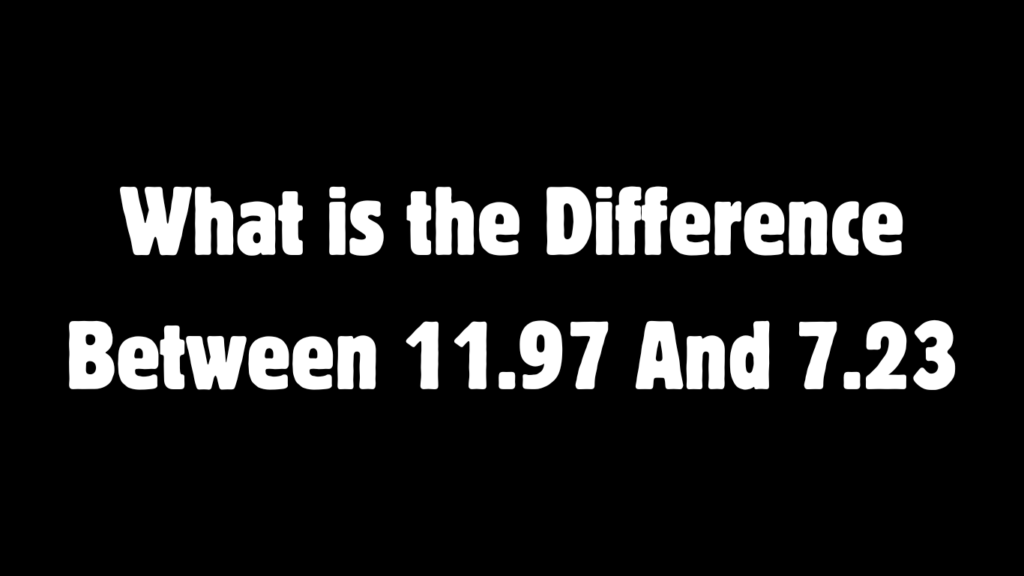Numbers play a crucial role in various aspects of life, from financial decisions to scientific measurements. Understanding the difference between 11.97 and 7.23 goes beyond simple subtraction—it delves into concepts of precision, decision-making, and real-world applications.
Whether evaluating budgeting implications, analyzing numerical trends, or exploring psychological perceptions, recognizing this difference helps in making informed choices. This article examines the significance of 4.74, exploring its impact in finance, science, and everyday scenarios.
Mathematical Calculation: Simple Subtraction
The difference between 11.97 and 7.23 can be determined using simple subtraction:
11.97 – 7.23 = 4.74
This calculation is essential in many scientific, budgeting, and investment contexts. The principle of subtraction helps in understanding the effects of different numbers in various applications.
The accuracy of this fundamental concept tells us how significant small numerical changes can be. In different contexts, the impact of 4.74 can vary greatly.
Financial Implications: How the Difference Affects Money Matters
In finance, the difference between 11.97 and 7.23 plays a crucial role. This variation in numerical values can translate into:
- Higher costs in purchasing and expenses
- A significant change in investments and profit
- Variations in salary, earnings, and returns
- Influence on budgeting and financial stability
- Impact on accumulation and compounding over the years
For instance, if a product costs 11.97, but a cheaper option is 7.23, choosing the lower-priced item saves 4.74. This seemingly small difference can add up over time, influencing decision-making and financial growth.
Scientific Accuracy: The Importance of Precision
In scientific fields such as medicine, engineering, and physics, even a small numerical difference can have a critical impact. The precision in measurement ensures:
- Correct dosages in medicine to avoid overdose
- Accurate readings in experiments and research
- Avoidance of miscalculation in environmental conditions
- Proper structure and stability in engineering
A 4.74 unit variation in a chemical reaction could result in an ineffective or dangerous outcome, highlighting the importance of calculated accuracy.
Real-Life Applications: Everyday Scenarios Where This Difference Matters
The numerical gap between 11.97 and 7.23 has real-world applications:
- Shopping: Choosing between items with a price variation of 4.74
- Travel: Booking flights where small fare changes impact budget
- Cooking: Measuring ingredients where grams of difference affect taste
- Consumer choices: Understanding perceived value based on pricing
In these scenarios, understanding the difference influences our decision-making in ways we might not even realize.
Psychological Perception: How We View Numerical Differences
Human perception of numerical values affects pricing strategies, consumer biases, and decision-making. Studies suggest that people focus on the absolute difference, even if it is small. Businesses manipulate this through discount pricing.
For example, a pricing shift from 11.97 to 7.23 might appear cheaper even if the context of savings is minimal. Psychological studies show that this significance is often more emotional than logical.
Comparing the Magnitudes of 11.97 and 7.23
The magnitude of difference depends on the context. In financial applications, a 4.74 shift in interest rates can be significant over a long-term investment.
In scientific research, a difference of this scale in units could lead to vastly different outcomes, particularly in physics and chemistry.
The Role of Precision: Why the Exact Values Matter
Precision is crucial in fields like finance, science, and engineering. Small differences can have significant consequences:
- In banking, a percentage shift can lead to a substantial profit or loss.
- In experiments, a slight decimal change can alter results.
- Rounding errors in datasets can lead to inaccurate projections.
Real-World Examples of Differences Between 11.97 and 7.23
Consider these scenarios where the difference plays a role:
- Business: A company’s profit margin shifting by 4.74% can determine its growth.
- Physics: The forces acting on an object could be impacted by a small variance.
- Consumer decisions: A price gap of 4.74 can make one product more attractive than another.
Interpreting the Difference: Statistical vs. Practical Significance
In data analysis, we must differentiate between statistical and practical significance. A difference of 4.74 may be statistically meaningful but practically irrelevant in some cases. In finance, engineering, and health-related studies, understanding this contrast is crucial for informed decision-making.
Summary and Key Takeaways
To summarize, the difference between 11.97 and 7.23 has broader implications. Whether in finance, science, or engineering, even a minimal variation can lead to profound outcomes. Recognizing these variances allows for better predictions and more accurate professional and everyday decisions.
Conclusion: Why the Difference Between 11.97 and 7.23 Matters
The difference between 11.97 and 7.23 is more than just a basic arithmetic subtraction. It encompasses mathematical concepts, financial calculations, and scientific measurements.
This numerical gap can significantly affect investment, purchasing decisions, and psychological perception. By understanding its implications, we gain a better grasp of the importance of precision in everyday life.


